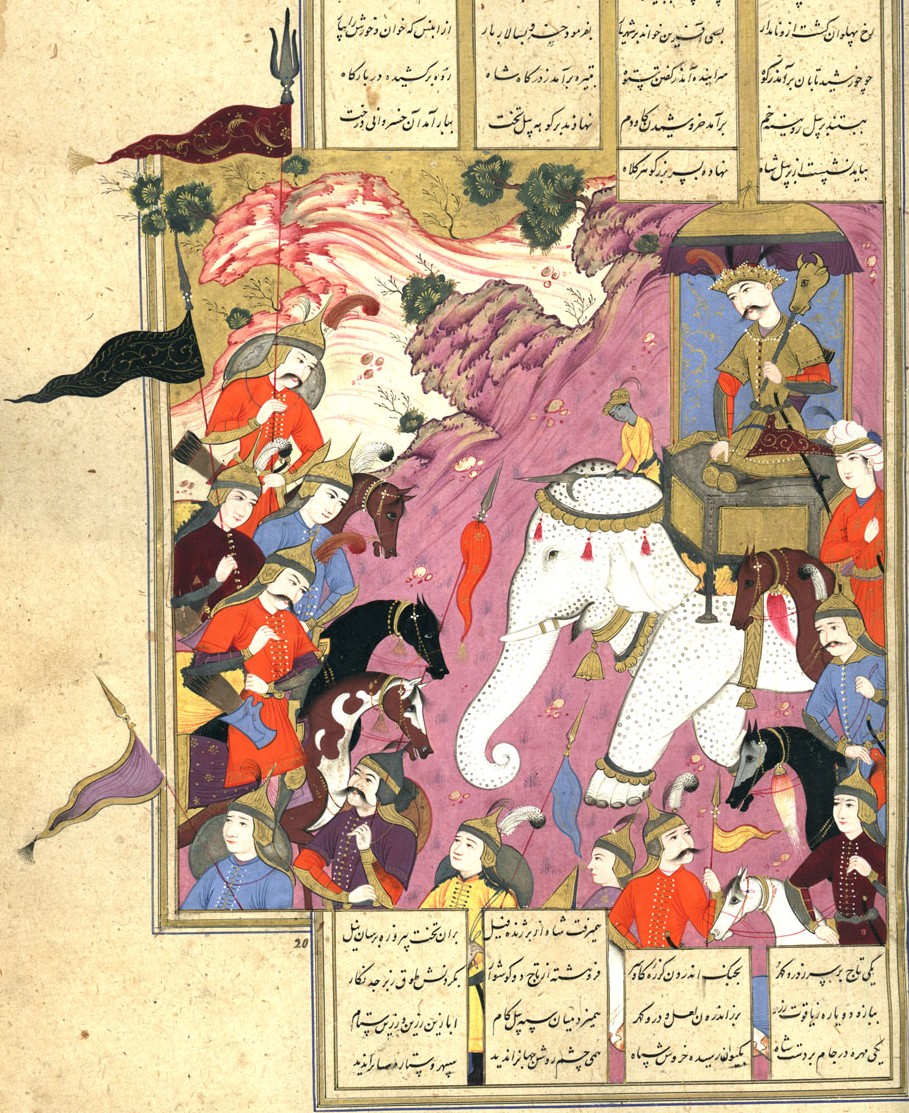|
|
Illustrations from the Shahnama showing Persian soldiers
Kay Khusrau reviews his troops, 1654
The figures wear contemporary dress or dress of no latter than the date of the illustration.
The actions portray the Sassanid/Sassanian period.

160 Kay Khusraw surveys his forces
Safavid Isfahan, Iran,
dated 29th Jumada II 1064 H / 16th May 1654
Illustrator: Muʿin Musavvir
Opaque watercolour, gold and ink on paper
37,9 x 23,5 cm
AKM 00274
Once again, the mighty armies of Iran prepare for battle, against their perennial enemies, the neighbouring Turanians. King Kay Khusraw is en-throned upon a majestic white elephant, reviewing his troops. The Iranian champions on horseback bow their heads to their shah, with pennants fluttering gaily from their lances, ready for battle. The ox-headed mace held by Kay Khusraw is associated with Faridun, the shah's ancestor. Following many long years of warfare with the Turanian king Afrasiyab, Kay Khusraw is finally and conclusively victorious over his enemy, but this victory does not ultimately bring contentment: Kay Khusraw's great military successes cause him to withdraw from the world rather than embrace it. Depicted here at the height of his power, this ambitious king will eventually abandon worldly pursuits for spiritual concerns baffling the military heroes at his court.
Dated 1654, this fine codex is the first of a two-volume copy of Firdawsi's Shahnama, richly illustrated by Muʿin Musavvir, a prolific artist of the seventeenth century, active from the 1630s to 1690s. The second volume is dated 1066 H / 1655-6 CE, and is now in the collection of the Chester Beatty Library in Dublin. Muʿin Musavvir had been trained by the painter Reza ʿAbbasi (d. 1635), who had dominated the Safavid visual mode in the early seventeenth century, and although other Indian and European vogues were becoming current as the century progressed, un-swervingly Muʿin continued to work in his teacher's - by now - traditional style (Soudavar 1992, 263-364).
A considerable corpus of Muʿin's work survived, including single-page drawings and illustrated manuscripts (Farhad 1990, n. 10; Canby 1998, 82-89), and also lacquered pen-boxes (Khalili - Robinson - Stanley 1996, pp. 38-43). He had at least two Safavid courtiers as portrait-sitters - 'Mirza Muhammad Baqir and his son Mirza Husayn' (AKM 00081), and 'The royal physician Hakim Shafa'i' (Collection of Princess Catherine Aga Khan IRM95; Canby 1998, pp. 87-88) - but yet there seems to be no evidence that he ever worked for the Safavid shahs, as he is not mentioned in the written sources. Almost in compensation for this, many of his drawings and paintings are signed and dated, and sometimes inscribed with yet further information regarding the precise location and circumstances of the work. For example, a series of drawings made in 1672 serve as record of a shocking event at the Safavid court when a diplomatic gift for the royal menagerie went out of control.
p. 109, Treasures of the Aga Khan Museum, Masterpieces of Islamic Art
|